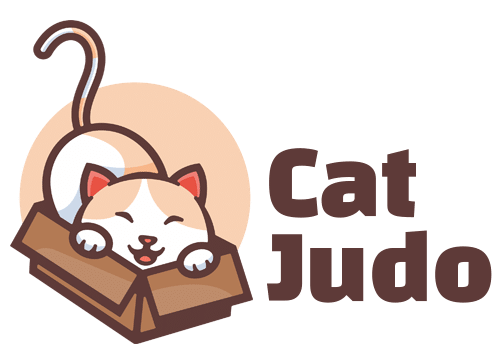Choosing the right food for your cat is essential. Healthy and happy animals require all the nutrients they need at different stages of their lives, which can be provided by feeding them the proper diet.
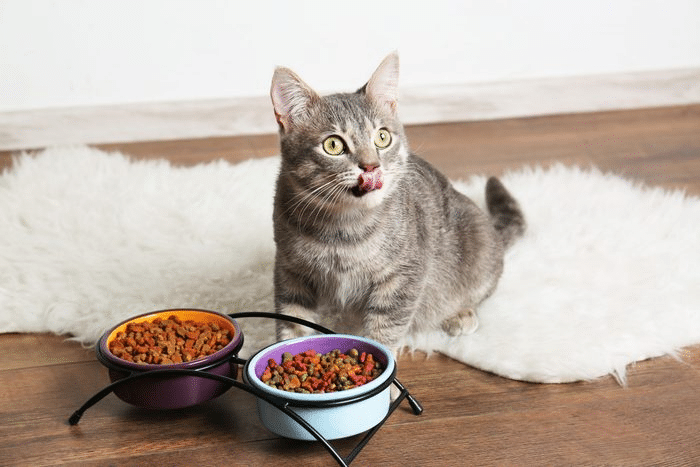
Source: google.com
What Is The Importance Of My Cat’s Diet?
Cats need the right food to stay healthy. To stay healthy and energetic, cats need a balanced diet every day.
The proper diet will give cats all the nutrients they need since cats can’t make some nutrients in their bodies. There are amino acids called Taurine and Arginine, essential protein components in the body, found only in animal meat and specific vitamins. This makes cats obligate carnivores, which means they eat only meat. These meat-based nutrients could make your cat extremely ill if not fed a diet that contains them. Heart and eye problems can be caused by taurine deficiency, and blindness can result.
You can also maintain your cat’s ideal weight by feeding them high-quality, complete cat food and watching their diet closely. Increasingly, pets in the UK are obese, leading to serious health problems such as diabetes and arthritis. Keeping track of your cat’s weight will allow you to spot any weight gain quickly so that you can adjust their diet accordingly.
Is There Something I Should Feed My Cat?
Choosing cat food can be overwhelming with so many options! The following factors should be considered when picking a cat’s diet:
Complete: Cats should continuously be fed complete foods to ensure they receive all the nutrients they need. The main diet of a child can be supplemented with small amounts of complementary foods.
Commercially available: Making your cat food can be challenging, so we recommend buying commercial cat food instead of making it at home.
Life stage appropriate: As your cat ages, the nutrients they need change – that’s why it’s essential to feed them the right food for their stage of life, whether they’re a kitten, adult or senior. Speak with your vet about ensuring your cat’s food is appropriate if they are pregnant, need to lose weight or have a chronic illness.
Pet Food Manufacturers Association (PFMA): Choose manufacturers who are members of the PFMA. Its members meet quality standards above and beyond those set by law.
Wet vs dry: Cats prefer variety in their food, so many owners mix wet and dry foods – check the label and calculate the correct portion sizes. When your cat isn’t interested in drinking, you can increase its water intake by feeding it a wet diet.
Flavour, texture and ingredients: Cats may prefer a particular type of food or enjoy a variety of flavours and textures. It doesn’t matter, as long as they are happy. At the same time, it’s nice to know what is in your cat’s food, and the ingredients list can be confusing. All pet food ingredients need to legally pass a vet inspection as ‘fit for human consumption’, so unless your cat has a food allergy, the exact ingredients don’t matter.
Nutrition For Cats On A Vegetarian Or Vegan Diet
Cats can have difficulty eating meat if they aren’t a meat eater. It’s tough for cats to survive and stay healthy on a vegetarian or vegan diet because they rely on meat for specific nutrients they can’t get from plant-based foods.
The best diet for your cat is always a complete commercial diet that is high in quality. It’s essential to make sure your cat will still receive all the nutrients it needs before feeding it vegetarian or vegan cat food. In case of doubt, consult your veterinarian.
A Cat’s Diet Must Contain Six Essential Nutrients.
The nutritional needs of cats are the same as those of their human parents. Choosing the right cat food is a matter of knowing what to look for among the many healthy options and brands that genuinely care about your cat’s wellbeing!
Protein is derived from animals.
A cat is fundamentally a carnivore! We rank animal protein first because of this reason.
Animal protein provides all the essential amino acids cats need. Among the many tissues and organs composed of proteins are cartilage, tendons, hair, skin, blood, muscles, and the heart. As well as enzymes and hormones, they also appear in antibodies.
Fish and eggs should also be included in a portion of complete & balanced cat food. Your cat’s claws and fur will remain strong and healthy if you feed it a healthy, well-balanced diet.
All Redbarn fillets are made with high-quality, fresh animal protein. Cats need an adequate intake of proteins to maintain their internal organs and muscles, which is why these recipes follow guidelines set by the Association of American Feed Control Officials (AAFCO).
Fats
Cats get their energy from animal fats. A “good fat” is any fat that is naturally present in meat, fish or essential fatty acids like Omega 3 and Omega 6. Feline health needs to consume these “good fats”.
Redbarn Pet Products’ Technical Director and Research and Development Scientist Steve Doerr said fats aid cats in maintaining body temperature, absorbing vitamins, and providing energy. Ensure your cat receives adequate omega three and omega six fats. Ensure the food you provide is enriched with them.
Carbohydrates
Despite being viewed as a non-essential nutrient in cats’ diets, carbohydrates play an essential role in their bodies. Every cat food should contain carbohydrates since they are readily digestible and provide a source of energy.
Carbohydrates can be found in grains like wheat and rice that cats can eat. Many wet cat foods contain these grains, which have been pretreated to facilitate digestion and absorption by your cat. As soybeans and other legumes contain several antinutritional factors, uncooked carbohydrates should be avoided.
Water
The obvious answer here is to drink more water, but did you know cats tend to consume less than they need? The water content of a cat makes up 70 percent of its body. Redbarn Pet Products’ Director of New Product Development Lindsay Tracy commented that cats once lived in natural habitats with limited access to clean drinking water. It has evolved for cats to obtain most of their water through their food, which they obtain through evolution.
A Cat’s Body Needs Water To Function Correctly:
Nutrition should be distributed correctly, the temperature should be maintained, toxins should be eliminated, and nutrients should be metabolized.
Wet and canned cat food offer increased palatability, higher protein content, and high moisture content.
It is an excellent source of hydration for cats to consume wet food, typically 78 to 82 percent water. A great source of hydration is Redbarn filets.
Wet food can help your cat stay hydrated throughout the day as a kibble topper or a complete feed. Make sure your cat doesn’t suffer from dehydration! Ensure your cat always has access to water and wet food.
- Vitamins
All mammals require vitamins. It is essential to feed vitamins in the right proportions when it comes to vitamins. It is so important to choose a balanced and nutritious cat food because most vitamins are synthesised from raw materials in the food.
Your cat should receive the following essential vitamins through their diet.
-Vitamin A:
Vitamin A is a fat-soluble vitamin essential for a healthy immune system and vision. The body stores Vitamin A in fatty tissues or the liver rather than excreting it like water-soluble vitamins. Because of this risk, your cat can become toxic if he consumes too much Vitamin A. Veterinary supervision is required when taking Vitamin A supplements.
-Vitamin D:
Your cat’s body needs vitamin D to maintain calcium and phosphorus balance. Known as “the sunshine vitamin,” vitamin D helps maintain a healthy bone, nerve, and muscle structure. It is also fat soluble, so excess vitamin D consumption shouldn’t be encouraged.
-Vitamin B1 (Thiamine):
This water-soluble vitamin is essential for the healthy metabolism of carbohydrates and the transmission of nerve impulses and expected growth.
-Vitamin B2 (Riboflavin):
To grow and stay healthy, riboflavin is essential. In addition to producing energy for the body, it allows oxygen to be used. Vitamin E helps your cat’s skin and coat stay healthy. Your cat’s skin around the eyes and abdomen could be adversely affected by a lack of Vitamin B2.
-Vitamin B3 (Niacin):
To maintain adequate levels, your cat’s urine depletes this water-soluble vitamin and needs to be replaced regularly. It is essential for the health of your cat’s nervous system, digestive system, and skin that he consumes vitamin B3.
-Vitamin B6 (Pyridoxine):
In addition to being water-soluble, vitamin B6 belongs to the group of B vitamins. Vitamin B6 is made up of three compounds. To maintain adequate levels of vitamin B6, your cat must get vitamin B6 constantly from a constant source. The function of red blood cells and the immune system are both influenced by vitamin B6. B6 is required to metabolize protein in more significant quantities when consumed more frequently. The body uses it to produce energy and distribute oxygen by breaking down carbohydrates, proteins, and fats. Cats with vitamin B6 deficiency may suffer from growth depression, seizure disorders, and irreversible kidney damage. Rarely does one encounter a B6 deficiency.
- Minerals
All mammals require minerals, just as vitamins do. In addition to forming enzymes, maintaining pH balance, utilizing nutrients, and transporting oxygen, minerals also play a role in enzyme production. It is common for earth and water minerals to be chelated, which is when they are bound with other organic substances, making them easier to absorb. A few minerals are essential to the health of our cats, according to Steve Doerr. This group belongs to minerals such as iron, calcium, magnesium, potassium, sodium, and chloride.
-Iron:
Fish, whole grains, liver, lean meats, and legumes contain iron. Supplemental iron is commonly found in most commercial cat foods to help meet dietary requirements. The deficiency of iron caused by illnesses and parasites can cause your cat to be fragile, resulting in anaemia.
-Calcium:
Calcium is essential to the production of milk that female cats give to their kittens. Your cat’s overall health will benefit from a calcium-rich diet found in dairy products, eggs, bones, and leguminous plants. The body needs calcium for many functions. There are several problems caused by low calcium during pregnancy and lactation, including bone growth and formation, blood clotting, muscle contraction, nerve impulse transmission, and eclampsia.
Calcium makes up approximately 99% of the structure of bones and teeth, so calcium deficiency is commonly associated with rickets, a condition in which the bones become soft and fragile. Calcium deficiencies can be reduced by feeding a diet with adequate calcium levels.
-Magnesium:
It would be best if you gave your cat magnesium to keep its overall health well-balanced. Several vitamins and minerals in your cat’s body can be absorbed and used by magnesium. Protein production, enzyme function, and bone growth depend upon this vital mineral.
Some foods contain magnesium, including raw wheat germ, whole grains, soybeans, milk, and fish. Magnesium is not added as an additive in most cat foods, but the ingredients determine the mineral. It is pretty rare to suffer from magnesium deficiency, however, muscle tremors and weakness are symptoms of such a deficiency.
-Sodium:
As a result of sodium, nutrients are transferred to cells, and waste products are removed. For average growth and development, dry cat foods should contain no more than 0.2 percent sodium, according to the Association of American Feed Control Officials (AAFCO). In cats, sodium-rich foods may temporarily increase thirst and water consumption, but the excess sodium is excreted in the urine.
-Chloride:
Your cat’s body needs chloride to maintain a healthy alkali balance. Hydrochloric acid (HCl) is also produced by chloride in the stomach and helps digest proteins.
Approximately 0.3 percent chloride (on a dry matter basis) is recommended in kitten and cat foods, according to AAFCO. The minimum daily requirement for cat food is usually higher than what’s found in most cat foods.
Veterinary recommendations for mineral and vitamin supplements may be necessary if your cat’s food lacks the correct amount of vitamins and minerals. Your precious pussycat will be able to benefit from them by helping offset nutritional deficiencies.
Here’s How To Choose The Best Cat Food For Your Pet
Is there anything that makes cat food suitable?
As a first step, let’s ask the most critical judge
Your cat enjoys it very much. The top factor is whether your cat prefers a particular brand and variety of cat food (‘complete’ is essential, let’s discuss that next). There can be nutritional wonders in your cat’s food, but if he doesn’t like it, it’ll go to waste.
The product is labelled as ‘complete’. Following the guidelines of the PFMA (Pet Food Manufacturing Association), commercial cat food (and dog food) labelled ‘complete’ contains all the necessary nutrients in the right balance. Be assured that your cat is getting all the nutrients they need, even if you feel they would benefit from more variety in food types and flavours.
A label on cat food usually describes it as ‘complementary’ if it isn’t complete. Treats, in other words. A cat can’t live solely on Dreamies, no matter how much they might want to.
Dry or wet? Although a balanced diet is ideal, you don’t have to feed your cat wet and dry food. Cats with problem teeth may have difficulty chewing dry food, which is better for long-term dental health. Particularly in older cats, wet food provides more hydration and protein, which are crucial for kidney and urinary tract health.
Cat food must contain meat to be considered complete. Even though I am a vegetarian, I would never limit my cat’s meat intake. Certain amino acids, such as taurine, are only found in meat and fish, which cats cannot get from other sources. The recommendations include a meat-and-vegetable cat food product, which some cats enjoy (my cat won’t touch it!).
It’s also essential to get the best value for your money. It is possible to find many of our recommended cat foods on Amazon, but the prices can sometimes be inflated. Online pet suppliers and supermarkets are often the best places to buy pets.
What is the exact amount of meat?
Comparing the meat content of different cat foods can be tricky, even for the most diligent buyers. When cat foods display a ‘meat content’ on the packaging, they usually don’t go into specifics regarding meat percentages or ingredients.
Byproducts of the meat industry are often referred to as “animal derivatives” or “meat meals.” Yes, this is meat, and it’s completely safe (all pet food sold in the UK is safe for human consumption). However, it is not the meat that humans consume traditionally. Your cat may find it just as tasty as you do. It’s rich in essential amino acids (like taurine) that cats need and cannot live without.
The UK site Pet Food Expert can provide detailed information about the contents of your cat’s food. Up to 30 pet food manufacturers and information about ethics and meat content are covered.
How about kittens, senior cats, and sick cats?
One size does not fit all when it comes to complete cat food.
The diet of kittens needs to be higher in protein than that of adult cats since kittens proliferate. Food made especially for juniors is available from several reputable companies.
A senior cat is around seven years or older and needs food that is easier to chew and digest. Get your cat’s teeth checked by the vet if you notice them chewing on one side or growling. It is also recommended that older cats consume food that is lower in fat, salt, and phosphorus. An excellent guide to senior cat nutrition is available from Purina.
Choosing the best cat food is especially important for cats with diabetes and other conditions.
The Best Cat Food You Can Buy In 2022
Purina One Adult Cat Food Mini Fillets in Gravy: The best-wet cat food for adult cats
Purina is the world’s second-largest pet food company, behind Whiskas-maker Mars, with brands such as Felix, Gourmet, Go-Cat, and Friskies, as well as its One and Gourmet. The one wet pouches bumper pack is good value for money at 41p per 85g pouch, has high nutritional quality, and cats love it.
Served in a rich sauce, this box contains meat and fish pouches that are easy to chew and taste great. As with Whiskas and Felix, cats are equally attracted to the fillets and sauce, so you won’t end up with a plate of bland chunks after the kitty licks off the sauce. Despite being a picky eater who dislikes vegetables, my cat finished off his Ocean Fish & Green Beans plate.
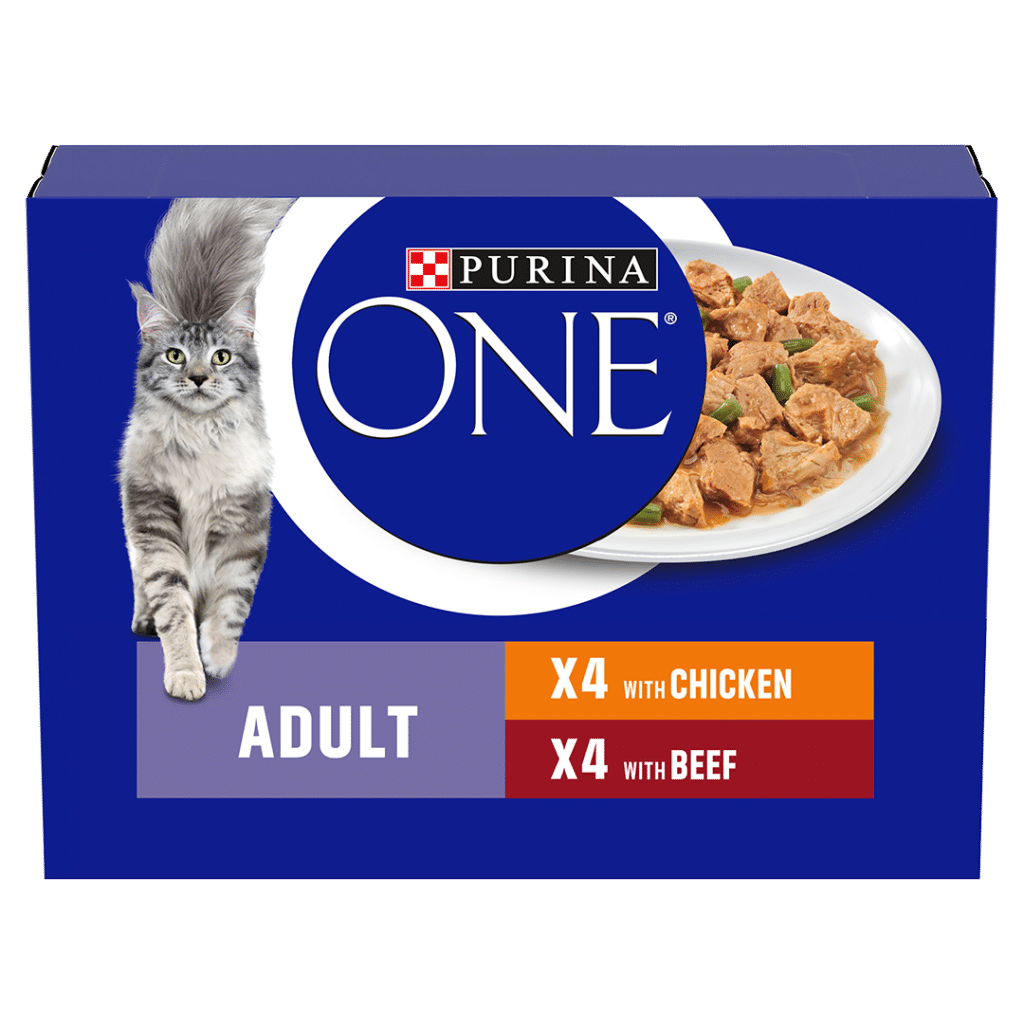
Source: google.com
IAMS for Vitality Dental Dry Cat Food: The best dry cat food for adult cats
As well as Iams, Whiskas, Sheba, Royal Canin, Kit-e-Kat and Dreamies, Iams is now part of Mars (yes, chocolate Mars). Iams is known for producing high-quality dry food, despite its Choccie link.
Flavours are limited (basically fish or chicken). With dry food, cats demand fewer flavour options, so it’s essential to find one that meets your high nutritional standards and makes your cat enjoy mealtimes.
Compared with most cat foods, including some wet varieties, Iams contain 89% animal protein. It supports a healthy immune system and digestive system and reduces tartar buildup. It may be too hard on the teeth and gums of seniors.

Source: google.com
Harringtons Complete Senior Chicken Dry Cat Food: The best dry cat food for senior cats and sensitive tummies
Older cats will benefit from Harringtons’ wet and dry food. Smaller chicken kibbles and finely chopped wet food make it easier for pets to chew and digest than many mainstream dry food varieties. Owners of senior kitties, whose sensitive tummies can’t tolerate richer dry food, and even those whose teeth are past their prime, are raving about Harringtons’ great-smelling kibbles. Moreover, they are a great source of antioxidants that support heart health and vision.
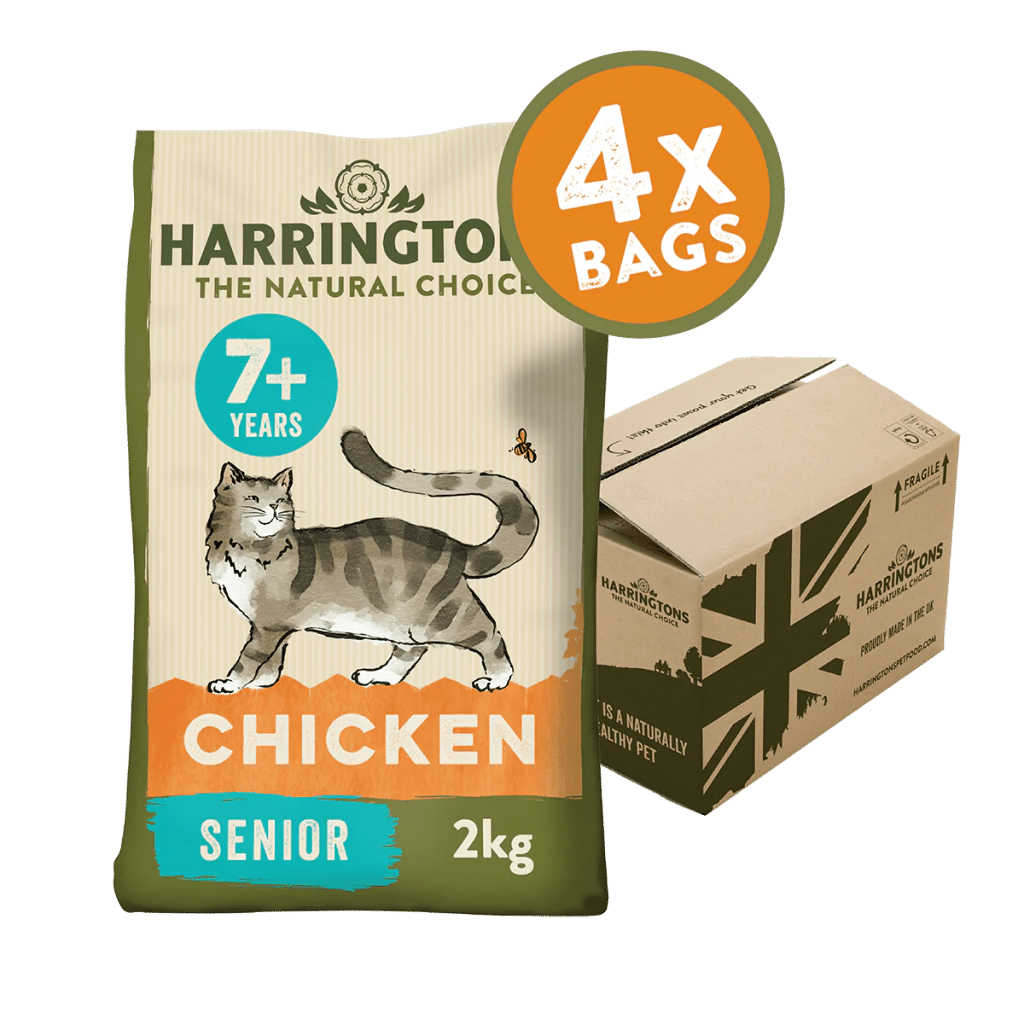
Source: google.com
Royal Canin Feline Health Nutrition Sterilized Adult Wet Cat Food Jelly: The best-wet cat food for weight control.
The first pet food brand to provide foods tailored to different breeds and sizes of dogs and cats was Royal Canin, now owned by Mars. In addition to being complete, this meaty wet food for neutered cats (which is to say, most healthy domestic cats) is balanced in energy and fat to keep relatively inactive cats from gaining excessive weight. Cats who don’t like wealthy foods will enjoy this product since it supports their urinary health.
It isn’t possible to choose from a variety of flavours. According to Royal Canin, cats care more about nutritional quality than flavour varieties in their food, which is why it differentiates its food based on the type of cat it is aimed at. Royal Canin comes highly recommended by veterinarians, but my cat isn’t convinced.
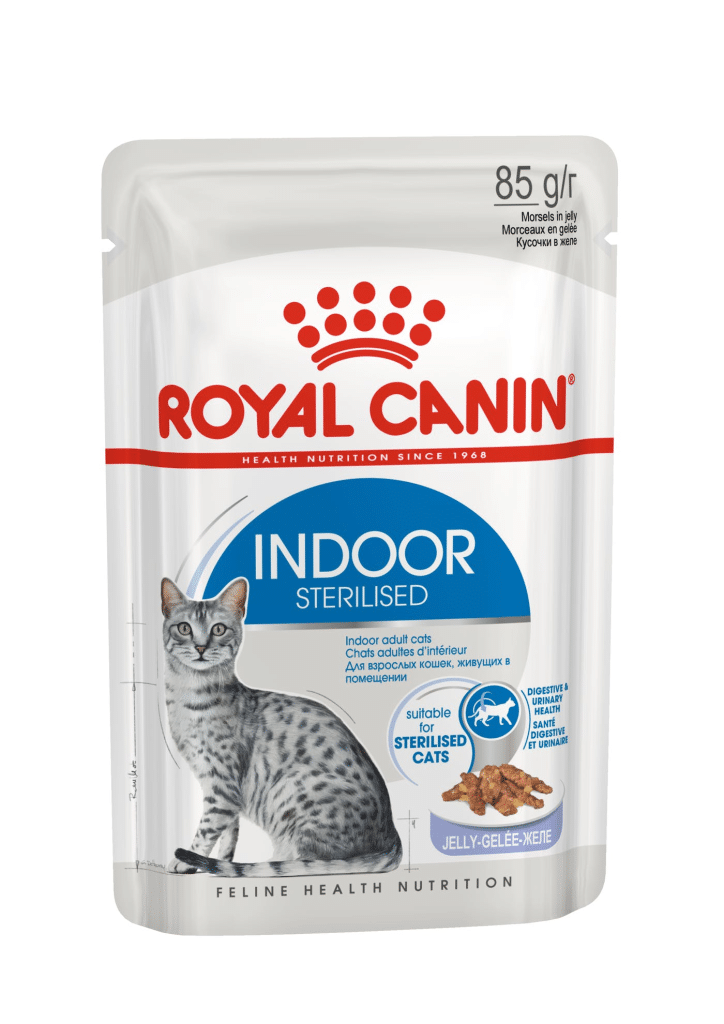
Source: google.com
Scrumbles Kittens & Queens Chicken: The best dry food for kittens and cats with sensitive tummies
In this high-protein, gluten-free cat food, 77% of the protein comes from chicken, while vitamins and minerals have been added for gentle digestion. It is an excellent choice for any cat with a sensitive stomach, as long as they drink plenty of water. It is labelled for kittens and queens (breeding female cats), who need high levels of protein, vitamins, and minerals.
Featuring ‘human grade meat’, responsibly sourced in the UK and Ireland, and packaged in recyclable packaging, Scrumbles will appeal to eco-conscious cat owners.
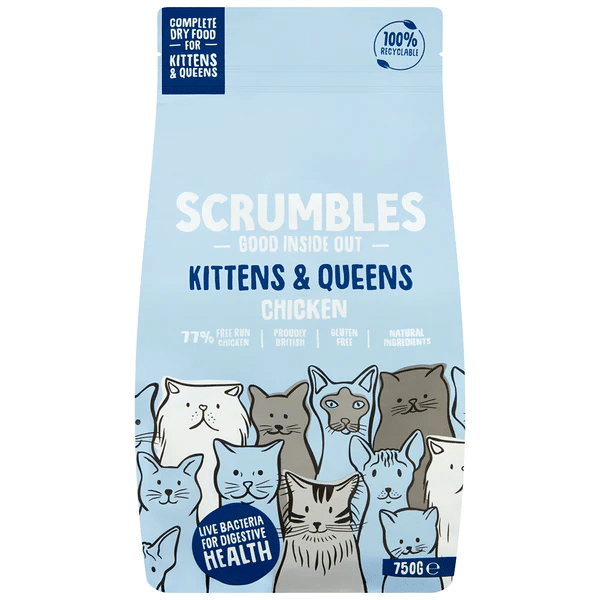
Source: google.com
Treats for cats
The occasional treat is a favorite of many cats, but it is important to remember that cats process their food and calories differently. A small treat may seem like a lot of calories to our cats since they are smaller.
The treats you give your cat are considered ‘complementary’ food, meaning they are fed on top of their regular diet. The treats you give your cat will take up a portion of their daily calorie allowance without providing the right balance of nutrition; as long as you feed a complete diet to your cat, you don’t need to give them treats to meet their nutritional needs. If your cat is used to getting lots of treats, they might not enjoy their regular food, so they may not get the nutrients they need. To ensure your cat stays healthy, you must continue feeding it regular cat food.
Be sure to count the treats your cat receives towards their daily allowance if you feed them treats. Many cats come with a calorie label on the packet, so you can keep an eye on the little extras to ensure they don’t add up. When giving your cat a treat, reduce their regular food allowance by around 10% if you’re uncertain how many calories it contains.
You should avoid giving your cat extra food treats if they are overweight or have a medical condition that prevents them from eating anything other than what they are already eating. It is possible to find other ways to ‘treat’ them instead. Why not spend time with them or play a game instead? Put some of their regular food aside in a puzzle feeder or during training – this is a great way to exercise their minds and bodies.
Also: Read here.
Conclusion
Nutrition and pure ingredients are vital to keeping your cat healthy and happy. Our curated list is intended to help you find the best formulas for your feline friend, depending on their needs and preferences.
FAQs
Is it okay to give milk to my cat as a treat?
There is no truth to the myth that cats need milk in their saucers. The lactose in cow’s milk can upset cats’ stomachs because they have difficulty digesting it. Your cat will also gain weight if it consumes cream and dairy products. It is possible to buy cat milk without lactose for your cat, but it is still high in calories and contains no nutrients that he would not get from his regular food.
Is it okay to feed my cat human food?
Your cat can eat some human foods. When given occasionally, a few tuna flakes or a small amount of boiled chicken breast can be a tasty treat for your cat. To keep your cat at a healthy weight, you should feed cat-sized amounts of food rather than human food. Some human foods are toxic to cats, so if in doubt, stick with food made specifically for cats and skip the scraps.
